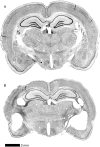Combined lesions of hippocampus and subiculum Do not produce deficits in a nonspatial social olfactory memory task
- PMID: 10884330
- PMCID: PMC6772337
- DOI: 10.1523/JNEUROSCI.20-14-05468.2000
Combined lesions of hippocampus and subiculum Do not produce deficits in a nonspatial social olfactory memory task
Abstract
Rats transmit information to each other about which foods are safe to eat. If a rat smells a food odor on the breath of another rat, it is subsequently more likely to eat that food than an alternative. Work by Galef et al. (1988) has shown that the observer rat forms an association between two olfactory stimuli on the breath of the demonstrator rat that has eaten the food, the food odor and carbon disulphide, which is normally present in the rat breath. Bunsey and Eichenbaum (1995) claimed that the hippocampus/subicular region is required for the long-term retention of this nonspatial form of associative memory on the basis that combined lesions of the hippocampus and subiculum produced a deficit, but lesions of either structure alone did not. We report here a failure to repeat this finding. Rats with either combined lesions of the hippocampus and subiculum or with amygdala lesions were tested on their ability to remember this association either immediately (testing short-term memory) or after a 24 hr delay (testing long-term memory). Neither lesion group exhibited significant memory deficits on this nonspatial associative task at either test interval. In contrast, a deficit was observed on a spatial memory task (forced-choice alternation t-maze) for animals with combined lesions of the hippocampus and subiculum. These results contradict the findings of Bunsey and Eichenbaum (1995) and support the idea that the hippocampus/subicular region is not required for this nonspatial associative memory.
Figures










References
-
- Aggleton JP, Hunt PR, Rawlins JNP. The effects of hippocampal lesions upon spatial and non-spatial tests of working memory. Behav Brain Res. 1986;19:133–146. - PubMed
-
- Barnes CA. Spatial learning and memory processes: the search for their neurobiological mechanisms in the rat. Trends Neurosci. 1988;11:163–169. - PubMed
-
- Beck M, Galef BG., Jr Social influences on the selection of a protein-sufficient diet by Norway rats (Rattus norvegicus). J Comp Psychol. 1989;103:132–139.
-
- Bunsey M, Eichenbaum H. Selective damage to the hippocampal region blocks long-term retention of a natural and non-spatial stimulus-stimulus association. Hippocampus. 1995;5:546–556. - PubMed
Publication types
MeSH terms
Substances
LinkOut - more resources
Full Text Sources
Medical
